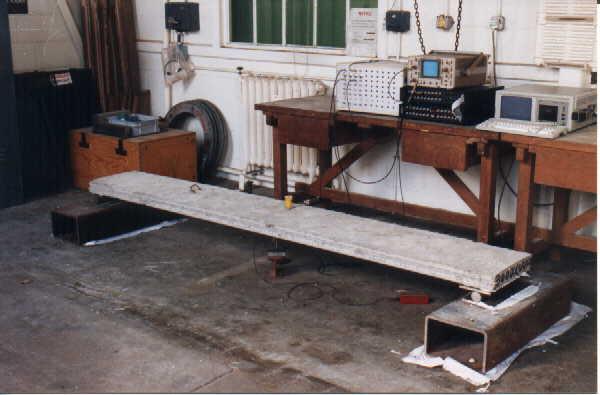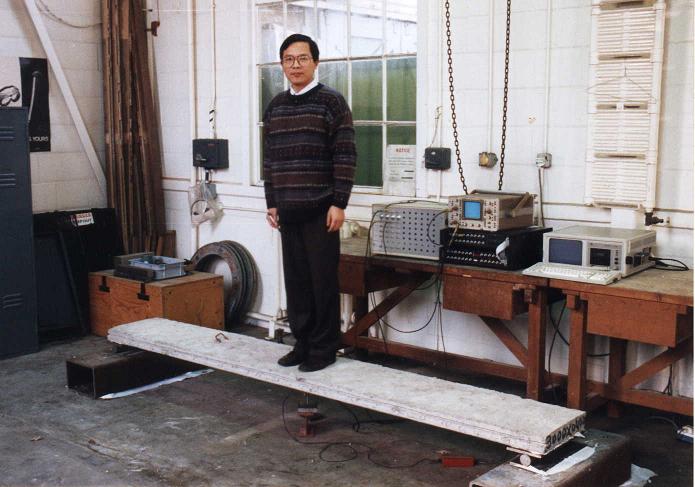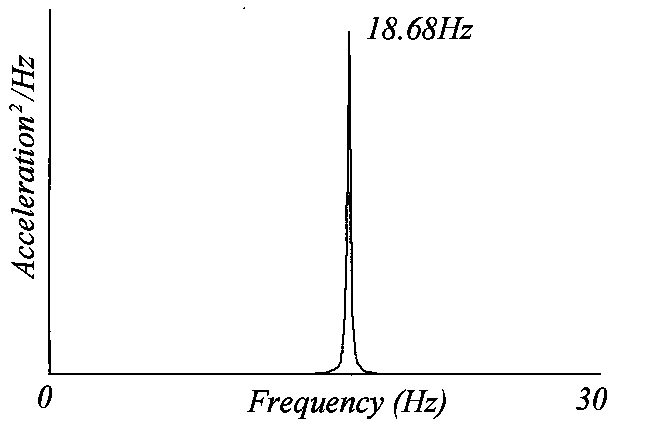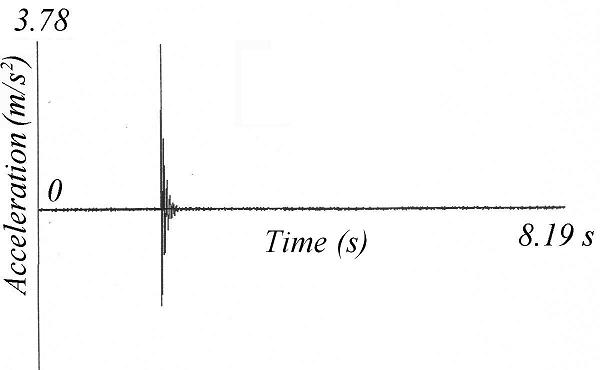The body model of a standing person in the vertical direction
The tests demonstrate that a standing person acts as a mass-spring-damper rather than an inert mass in vertical structural vibration while a walking or jumping person acts solely as loading on structures.


a) An empty beam b) A person standing on the beam
Fig. 19-6: Test set-up for identifying human body models in vertical structural vibration
Fig. 19-6a shows a simply supported reinforced concrete beam with an accelerometer placed at the centre of the beam. Striking the middle of the beam vertically with a rubber hammer caused vertical vibrations of the beam. The acceleration-time history recorded from the beam and the frequency spectrum abstracted from the record are shown in Figs. 19-7a and 19-7b. It can be observed that the simply supported beam has a vertical natural frequency of 18.7 Hz and the system has a very small damping ratio shown by the decay of the free vibrations which lasts more than eight seconds.


a) Free vibration of the beam alone b) Response spectrum of the beam alone


c) Free vibration of a human-beam system d) Response spectrum of the human-beam system
Fig. 19-7: Measurements of the identification tests in vertical directions [19.2]
A person then stood on the centre of the beam as shown in Fig. 19-6b and a human-structure system was created. A rubber hammer was again used to induce vibrations. Figs. 19-7c and 19-7d show the acceleration-time history and frequency spectrum of the beam with the person. Comparing the two sets of measurements in Fig. 19-7 shows that:
- the measured vertical natural frequency of the beam with the person was 20.0 Hz which is larger than that of the beam alone (Figs 19-7b and 19-7d). This observation coincides with Relationship 3, i.e.
 .
. - the beam with the person possesses a much larger damping ratio than the beam alone as the free vibration of the beam with the person decays very quickly (Fig. 19-7c). This is also evident from Fig. 19-7d as the peak in the spectrum of the beam with the person has a much wider spread than that of the beam alone (Fig. 19-7a).
Further tests were conducted to identify the effects qualitatively of human bodies in structural vibration, including tests on the beam with a dead weight and the beam occupied by a person who moved, both jumping and walking. The measured frequencies for these cases are listed in Table 19-1, which shows:
- the dead weights, which were placed centrally on the beam for two tests, reduced the natural frequency as expected. This can be accurately predicted using Eq. 19-1.
- the test with the person standing on the beam showed an increase in the measured natural frequency. This observation cannot be explained using the inert mass model or Eq. 19-1. Thus it is clear that the standing human body does not act as an inert mass in structural vibration.
- the measured frequency for the vibrations when the person sat on a stool on the beam was also higher than that of the beam alone.
- significant damping contributions from the human whole-body were observed for both standing and sitting positions, as can be appreciated from Fig. 19-7 for the standing person.
- jumping and walking also provided interesting results in that they did not affect either natural frequency or damping. The unchanged system characteristics would appear to be because the moving human body is not vibrating with the beam.
Table 19-1: Natural frequencies observed on the beam [19.2]
Description of experiments |
Measured natural frequency (Hz) |
Bare beam (Fig. 19-6a) |
18.7 |
Beam plus a mass of 45.4 kg (100 lb) |
15.8 |
Beam plus a mass of 90.8 kg (200 lb) |
13.9 |
Beam with T. Ji standing (Fig. 19-6b) |
20.0 |
Beam with T. Ji sitting on a high stool |
19.0 |
Beam with T. Ji jumping on spot |
18.7 |
Beam with T. Ji walking on spot |
18.7 |
Two concepts can be identified from the above tests:
- A stationary person, e.g. sitting or standing, acts as a mass-spring-damper rather than as an inert mass in structural vibration.
- A walking or jumping person acts solely as loading on structures.
